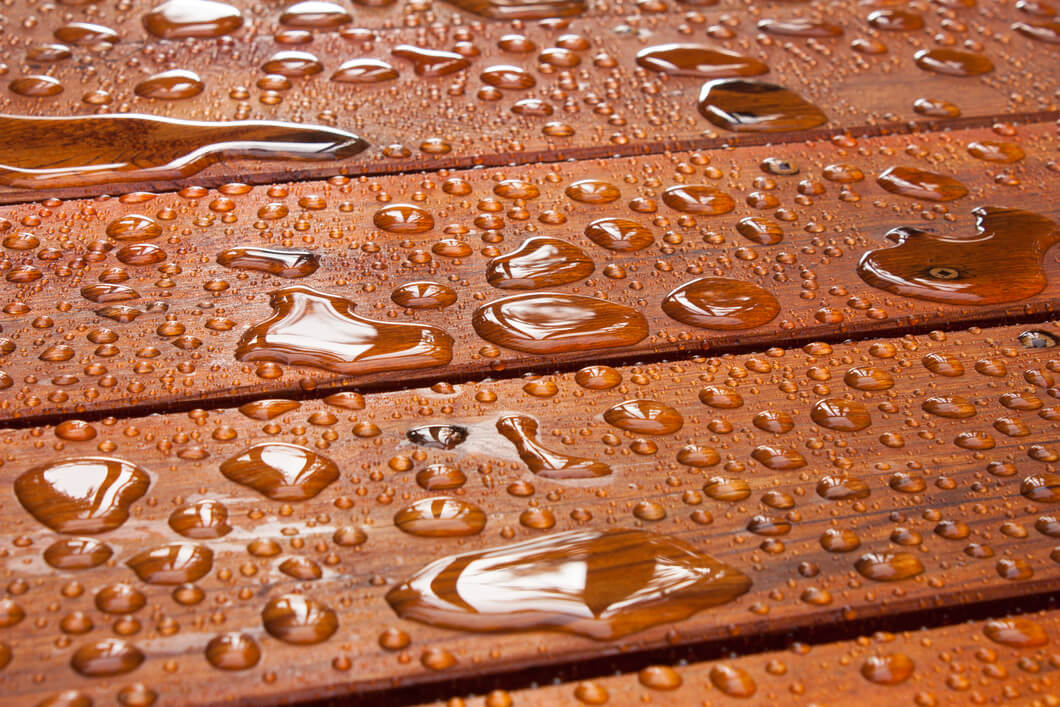Deck wood sealant is a protective coating that helps extend the lifespan of your deck by sealing the wood against moisture and other damage. A deck is a great addition to any home, providing a space for relaxation and outdoor gatherings.
However, exposure to the elements can take a toll on the wood, causing it to deteriorate over time. That’s where deck wood sealant comes in. By applying a sealant to your deck, you create a barrier that prevents water, UV rays, and other harmful elements from penetrating the wood.
This helps to prevent warping, cracking, and decay, keeping your deck looking beautiful and structurally sound for years to come. Whether you have a newly built deck or an older one in need of some TLC, using a high-quality wood sealant is essential for its long-term preservation.
Benefits Of Deck Wood Sealant
Using a deck wood sealant is one of the best ways to protect and enhance the beauty of your outdoor deck. The benefits of applying a high-quality sealant go beyond simple aesthetics. In this blog post, we will explore different advantages of using deck wood sealants.
Longevity
Deck wood sealant greatly extends the lifespan of your deck. By applying a sealant, you create a protective barrier that shields the wood from moisture, sunlight, and everyday wear and tear. This protective layer helps prevent the wood from rotting, warping, or splintering, ensuring your deck remains sturdy and safe for years to come.
Protection From Elements
The primary purpose of a deck wood sealant is to provide robust protection against the elements. Whether it’s rain, snow, or intense sunlight, your deck is constantly exposed to harsh weather conditions. A quality sealant forms a waterproof barrier that prevents water from seeping into the wood, protecting it from swelling or contracting due to moisture absorption. Additionally, the sealant acts as a shield against harmful UV rays, preventing the wood from fading or discoloration.
Moreover, a deck wood sealant guards against mold and mildew growth, which can occur in damp environments. By inhibiting these organisms’ growth, you not only preserve the aesthetic appeal of your deck but also maintain a healthier outdoor living space for you and your family.
In conclusion, the benefits of deck wood sealants are undeniable. They help enhance the longevity of your deck by safeguarding it against environmental elements. Moreover, they protect the wood from moisture damage, UV rays, and fungal growth. By investing in a high-quality sealant and properly applying it to your deck, you can enjoy a beautiful, long-lasting outdoor living space for years to come.

Credit: www.bobvila.com
Types Of Deck Wood Sealant
When it comes to protecting your deck wood from weathering and wear, applying a suitable sealant is paramount. Deck wood sealant not only enhances the appearance of your deck but also helps to prevent damage caused by moisture, UV rays, and general outdoor elements. There are two main types of deck wood sealants: water-based sealants and oil-based sealants.
Water-based Sealants
Water-based sealants, as the name suggests, are sealants that use water as the primary solvent. These sealants are a popular choice for homeowners for several reasons. Firstly, water-based sealants are easy to apply and clean up. You can simply use soap and water for both application tools and your hands. This makes the entire process hassle-free and convenient.
Secondly, water-based sealants dry quickly, reducing the waiting time before you can use your deck again. Additionally, they have low volatile organic compounds (VOCs), making them environmentally friendly and safe for use around pets and children.
However, water-based sealants may require more frequent applications as they tend to wear off faster than their oil-based counterparts. Nevertheless, they are still an excellent option for deck protection.
Oil-based Sealants
Oil-based sealants are sealants that use oil as the primary solvent. These sealants have been popular for many years due to their durability and long-lasting protection properties.
One of the benefits of oil-based sealants is their exceptional water-resistance. The oil formulation creates a protective barrier on the wood, preventing moisture infiltration and reducing the risk of warping, rotting, or cracking.
When applied, oil-based sealants penetrate deep into the wood fibers, enhancing its natural beauty while providing superior protection against UV rays and general wear and tear.
Unlike water-based sealants, oil-based sealants generally require less frequent reapplication, saving you time and effort in the long run. However, it is crucial to note that oil-based sealants can take longer to dry and may emit stronger odors during the application process.
To summarize, both water-based and oil-based sealants offer excellent protection for your deck wood. While water-based sealants provide convenience and faster drying time, oil-based sealants are known for their long-lasting durability and moisture protection. Ultimately, the choice between the two depends on your specific needs and preferences.
Application Process
Applying a wood sealant not only protects your deck from moisture and decay but also enhances its natural beauty. The application process is crucial to ensure the sealant effectively penetrates and safeguards the wood. Proper surface preparation and methodical sealant application are essential for a durable finish. Below, we’ll delve into the detailed application process for deck wood sealant.
Surface Preparation
Before applying the sealant, it’s imperative to prepare the deck surface meticulously. The following steps will help ensure the wood is ready to receive the sealant:
- Clean the Surface: Remove any dirt, debris, and mildew using a suitable wood cleaner and a stiff-bristled brush.
- Repair Damage: Address any cracks, splits, or damage to the wood by filling them with a suitable wood filler.
- Sand the Surface: Smooth the wood surface by sanding it with fine-grit sandpaper to create a uniform and smooth texture.
- Remove Dust: After sanding, thoroughly clean the deck to remove any dust or particles that could affect the sealant’s adhesion.
Sealant Application
Once the surface is prepped, proceed with the application of the wood sealant using the following guidelines:
- Choose the Right Conditions: Select a day with moderate temperature and low humidity to ensure optimal conditions for application.
- Stir the Sealant: Thoroughly stir the sealant to ensure an even consistency and proper incorporation of any additives.
- Start Application: Use a brush, roller, or sprayer to apply the sealant in smooth, even strokes following the wood’s grain.
- Overlap Strokes: Ensure each stroke slightly overlaps the previous one to achieve uniform coverage.
- Allow Drying Time: Let the sealant dry according to the manufacturer’s instructions, and apply additional coats if necessary for enhanced protection.
Maintenance And Reapplication
Proper upkeep of your deck wood sealant is crucial to ensure its longevity and effectiveness. Regular maintenance and timely reapplication play a vital role in preserving the beauty and durability of your deck. Here are key aspects to consider:
Cleaning And Inspection:
Regularly clean the deck surface and inspect for any signs of wear or damage.
- Remove dirt, debris, and mildew using a gentle cleaner and a soft brush.
- Inspect for cracks, peeling, or discoloration that may indicate the need for resealing.
Reapplication Schedule:
Follow a regular schedule for reapplying the deck wood sealant to maintain its protective properties.
- For low-traffic areas, reapply every 2-3 years.
- High-traffic areas may require reapplication every 1-2 years.
Choosing The Right Sealant
Choosing the Right Sealant for your deck wood is crucial in maintaining its longevity and protecting it from weather elements. Let’s dive into the key considerations to help you make an informed decision.
Deck Material Compatibility
- Check that the sealant is suitable for your specific deck material to prevent damage.
- Ensure compatibility with wood types like cedar or pressure-treated lumber.
- Verify if the sealant works well with composite decking or exotic hardwoods.
Environmental Impact
- Consider eco-friendly options that have low VOC content for a minimal environmental impact.
- Look for sealants made from sustainable materials that are biodegradable.
- Opt for water-based sealants to reduce harmful chemicals exposure.

Credit: www.cladcodecking.co.uk
Frequently Asked Questions On Deck Wood Sealant
What Is The Best Sealant For Wood Deck?
The best sealant for a wood deck is a high-quality, oil-based, penetrating sealant. It provides long-lasting protection and enhances the natural beauty of the wood. Look for products with UV protection and water resistance for optimal performance and durability. Regular application is key for maintenance.
Should A Wood Deck Be Sealed?
Yes, a wood deck should be sealed. Sealing helps protect the wood from water damage, UV rays, and wear and tear. It also enhances the deck’s appearance and prolongs its lifespan. Regular sealing every few years is recommended to maintain the deck’s condition.
How Do You Seal An Old Deck?
To seal an old deck, follow these steps:
1. Clean the deck thoroughly with a deck cleaner.
2. Make any necessary repairs to the deck, like replacing rotting or loose boards.
3. Sand the deck to smooth out any rough spots or splinters.
4. Apply a waterproofing sealer evenly to the deck, using a brush or roller.
5. Allow the sealer to dry completely before using the deck again.
Can You Seal A Deck Without Sanding?
Yes, you can seal a deck without sanding. Use a deck cleaner and a power washer to prepare the surface before applying a sealant. This method will help the sealant adhere to the wood effectively.
Conclusion
To seal and protect your deck wood, choosing the right sealant is crucial. With the variety of wood sealant options available, it’s important to consider your specific needs and budget. Whether you prefer a natural finish or a colored look, a high-quality wood sealant will enhance the beauty and longevity of your deck.


